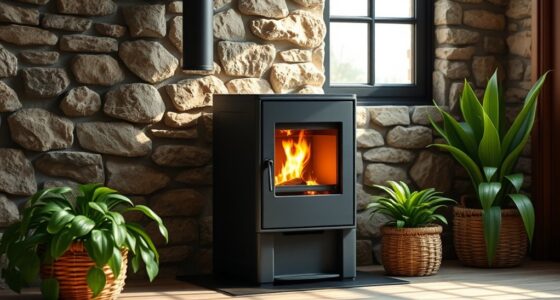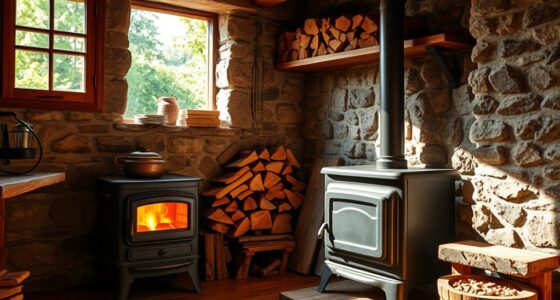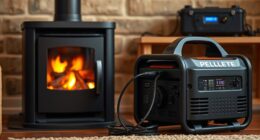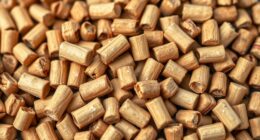Burning wood in your stove releases PM2.5 particles into the air, which can harm your respiratory health and worsen local air quality. These tiny particles can penetrate deep into your lungs and even enter your bloodstream. During cold months, increased stove use can lead to smog formation and regional pollution. Understanding how stove emissions impact your environment and health can help you take steps to reduce pollution, and if you keep exploring, you’ll find effective ways to improve air quality around you.
Key Takeaways
- Wood stove combustion releases PM2.5 particles that can degrade local air quality and contribute to smog formation.
- PM2.5 particles penetrate deep into lungs, posing health risks, especially during high stove usage in winter.
- Multiple stoves in a community increase regional PM2.5 levels, affecting residents’ respiratory health.
- Proper stove maintenance and cleaner burning techniques can significantly reduce emissions of harmful particles.
- Managing stove use during peak pollution times and adopting cleaner technologies protect community air quality.
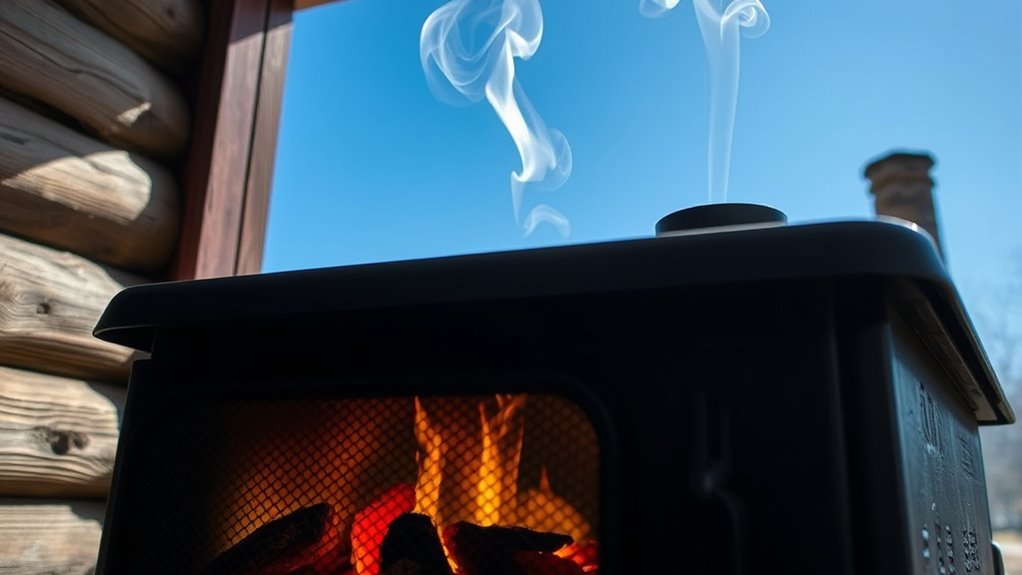
Wood stoves are a popular choice for heating homes, especially in rural areas, but they can considerably impact local air quality. When you burn wood in your stove, the process releases combustion emissions into the air. These emissions include a mixture of gases and tiny particles, like PM2.5—particulate matter smaller than 2.5 micrometers. Because of their size, these particles can easily penetrate deep into your lungs and even enter your bloodstream, posing serious risks to air pollution health. Understanding how wood stove emissions contribute to local pollution helps you see the importance of managing their impact.
Every time you light a fire, your stove produces combustion emissions that release PM2.5 into the atmosphere. These particles are not only harmful to your lungs but also affect the air quality in your community. In areas with many wood stoves operating during cold months, the cumulative effect can substantially elevate PM2.5 levels, leading to smog formation and increased health risks. Fine particles like PM2.5 are especially concerning because they bypass the body’s natural defenses, lodging deep in your respiratory system and causing issues such as asthma, bronchitis, and even cardiovascular problems over time. Additionally, choosing cleaner-burning stoves and proper burning techniques can significantly reduce these emissions and improve overall air quality.
The link between combustion emissions from wood stoves and air pollution health is well-documented. Exposure to high levels of PM2.5 has been associated with respiratory inflammation and reduced lung function. Vulnerable groups—children, the elderly, and those with pre-existing health conditions—are particularly at risk. If you or someone in your household already suffers from respiratory issues, the presence of wood stove emissions can exacerbate symptoms and lead to more frequent hospital visits. Additionally, these fine particles can travel beyond your immediate neighborhood, contributing to regional air quality problems and impacting the health of nearby communities. Understanding and addressing air pollution health risks associated with wood stove emissions is crucial for community well-being.
Frequently Asked Questions
How Do Different Wood Stove Models Impact PM2.5 Emissions?
Different wood stove models impact PM2.5 emissions based on their stove efficiency and adherence to emission standards. More efficient stoves burn wood completely, reducing smoke and particulate matter. Models that meet strict emission standards emit markedly less PM2.5, helping improve local air quality. By choosing a high-efficiency stove that complies with current standards, you can lower your emissions and contribute to cleaner air in your community.
Are There Government Incentives for Upgrading to Cleaner Wood Stoves?
Sure, government grants and subsidy programs make upgrading to cleaner wood stoves easier, even if it feels like a surprise. You can often get financial help to switch to models that emit less PM2.5, improving air quality while saving money. So, don’t miss out—check your local or federal programs. It’s a win-win, and yes, the government actually wants you to breathe cleaner air!
What Are the Health Effects of Long-Term PM2.5 Exposure From Wood Stoves?
Long-term PM2.5 exposure from wood stoves can seriously impact your respiratory health, leading to chronic bronchitis and reduced lung function. It also increases your cardiovascular risk, raising chances of heart attacks and strokes. You might not notice immediate symptoms, but over time, these tiny particles damage your lungs and heart. To protect yourself, consider upgrading to cleaner stoves and improving ventilation in your home.
How Does Weather Influence PM2.5 Dispersal From Wood Stove Emissions?
Imagine PM2.5 particles as tiny invaders waiting to settle on your neighborhood; weather dramatically influences their dispersal. Airflow patterns carry these particles far and wide, especially when wind is strong, spreading pollution. But during temperature inversions, a thick, invisible lid traps emissions close to the ground, causing PM2.5 levels to skyrocket. You’ll notice smog hanging stubbornly, making it harder for the particles to disperse and clear out.
Can Residential Ventilation Systems Reduce Indoor PM2.5 Levels?
Yes, residential ventilation systems can reduce indoor PM2.5 levels by improving indoor air quality. You should guarantee your ventilation system has high efficiency to effectively filter and circulate fresh air, removing pollutants from indoor air. Regular maintenance and using filters designed for PM2.5 can further enhance ventilation efficiency. This helps you breathe cleaner indoor air, especially during periods of wood stove use or high outdoor pollution.
Conclusion
By choosing to use your wood stove responsibly, you can enjoy cozy warmth without turning your neighborhood into a smoky haze. Imagine a clear winter night, stars shining brightly above a peaceful community, instead of a hazy sky filled with harmful PM2.5. Your actions matter—ventilate properly and burn seasoned wood. Small choices today can keep your air clean tomorrow, allowing you and your neighbors to breathe easy and enjoy the crisp, fresh outdoor air.





